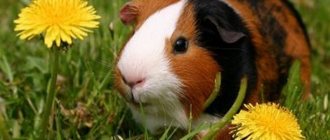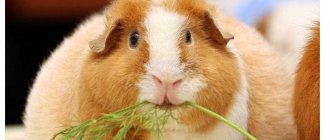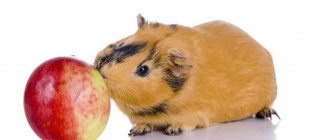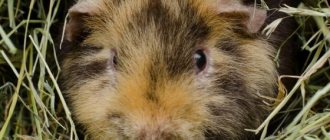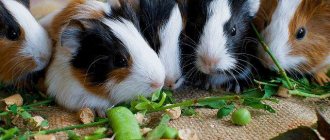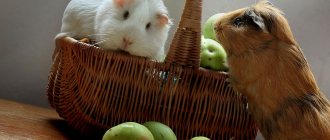Hair trimming for guinea pigs
How to cut a guinea pig's hair and which breeds need it? All long-haired breeds can be clipped, including Peruvian Guinea Pig, Texel and Sheltie. Hair grows approximately 2 cm per month.
Why groom guinea pigs?
So that it has a neat appearance, there are no lumps of debris and wool, and in the summer - to protect it from overheating. If this is a female who feeds the cubs, to provide the babies with access to the nipples. Also, aging guinea pigs, as well as those who suffer from intestinal diseases, get dirty hair in the anus. Another trouble that can happen is the appearance of fleas. It only makes sense to grow wool in one case - you are going to take part in an exhibition. In other options, the fur coat needs to be cut.
At what age should rodents be trimmed?
Males from 2 months, and females from one and a half months. The best thing to do is to look at the intensity of fur growth.
How to remove fur?
You can use scissors or a clipper. You need to start with scissors so that the animal gets used to manipulation. The first time the noise of the clipper causes concern and the pig freezes, which allows you to calmly cut it.
Where to cut wool?
First you need to cut off the tangles and what is dirty. Also remove the layer on the abdomen, near the anus. For the Peruvians - from the eyes and ears. And then trim it on the back and sides so that your pet looks neat.
Grooming, in addition to cutting, also includes combing. To do this, take a brush with soft bristles. You can scratch your guinea pig at least twice a day. Usually the animals like this procedure.
Those guinea pigs that have thick hair are given a pinch—trimming, or forced shedding. Abroad, this procedure is ordered in beauty salons for pets. Although, there is nothing complicated about it and you can do it while watching TV:
- a small tuft of wool is squeezed between the fingers and is not pulled very strongly, first with the growth of the fur, and then against it. And so on several times until the bundle remains in your hands;
- The frequency of trimming depends on the time of year and diet: the hotter, the more often. Nutritious food promotes intensive hair growth and the growth of such fluff.
Hair plucking is done on Teddy and Himalayan guinea pigs.
How to cut your hair at home
With a competent approach to trimming rodents' claws, the process itself at home will not be much different from the procedure in a pet salon or veterinary clinic. In any case, it consists of a preparatory stage (involves the acquisition and disinfection of all necessary tools and materials), as well as the sequential implementation of direct pruning, with strict adherence to the basic requirements for it.
What you need to prepare
If you already have rodents and you want to provide them with proper care, in addition to drinking bowls, bowls and houses, you should purchase a “manicure set”, which includes the following items important for cutting nails:
- a special nail clipper for rodents (if there is no place to buy one yet, an alternative would be children’s nail clippers or tongs/scissors for cats);
- an electric sharpener or scratching post (safer than the first option, because it helps to sharpen the claws to the desired length without the risk of touching blood vessels or nerve endings);
- hemostatic powder (sold in specialized stores with shaving accessories), starch or “Chlorhexidine”, which will come in handy if you still do not calculate your strength and damage the capillary;
- a towel (it is optional, but it will make it much easier to hold the guinea pig in your hands, and it will feel much more comfortable during the procedure);
- a fluorescent lamp to clearly see the preferred place to cut the claw.
Pruning rules
Trimming nails is stressful for most animals, so in order to complete all the steps as quickly and accurately as possible, you should follow some simple rules:
- It is better to start cutting the claws from the outermost finger and cut them in order, without missing a single one;
- if the animal begins to worry and struggle, take a short break so that the pet calms down;
- if necessary, try to distract the rodent after each claw cut by offering him his favorite treat;
- in some cases (mainly with very obstinate guinea pigs), it would be more logical to extend the process of trimming claws over several days;
- it is much easier to deal with the nippers if you involve another person in the procedure: one holds the animal, and the second quickly removes the excess part of the claws;
- To avoid problems with trimming the claws of guinea pigs in the future, it is advisable to accustom them to this at an early age, so that the rodent gradually gets used to the procedure and is no longer so worried.
Video: rules for trimming claws
With regular trimming of the tips of the claws, the animal's paws will always remain well-groomed, and it will not experience problems with its limbs.
Did you know? Guinea pigs are social animals. Not only do they prefer to live in packs, most of them need attention from humans, so for their harmonious development you will have to pet the rodents daily.
Procedure process
Having familiarized yourself with all the recommendations for the haircut process and having prepared the necessary tools and materials, it’s time to proceed to the actual procedure, based on the following step-by-step instructions:
- Carefully, without sudden movements, remove the pet from its cage, holding its jaw with the thumb of one hand and securing the animal from behind with the other.
- Wrap the animal in a prepared towel and place it on your lap, first turning it with its back (in this position it will not be so easy for it to bite).
- Try to calm your guinea pig by periodically stroking it and treating it with treats.
- If the pet is not aggressive and remains relatively calm, remove one paw from the towel and fix the claw of interest with your thumb and forefinger. You shouldn’t squeeze too hard, and if the rodent has already begun to worry, loosen your grip and wait until he calms down.
- Take the pliers in your free hand and place the tool in front of the claw.
- Determine the location of blood vessels in the tissues (for convenience, you can move the paw closer to the light source or shine it with a flashlight).
- Using clippers, cut off the desired part of the nail, just above the blood vessel. If it was not possible to determine its specific location, you need to cut off the claw in small parts.
- If blood does come out, stop it using a special powder or starch, simply sprinkling the substance on the cut site.
Once the nail trimming is complete, the animal is returned to its cage and allowed to calm down.
Preparation for the procedure
Before starting the procedure, you need to prepare your tools. For cutting you will need special tweezers. They are sold in pet stores and are called rodent nail clippers. A nail clipper for rodents can be replaced with children's tweezers or a nail clipper for cats. For very small piglets, regular nail scissors are also suitable, since babies have soft nails.
In cases where it is impossible to accurately determine the safe place to use a nail clipper, it is better to use a nail file. An ordinary nail file that people use or a special device - an electric sharpener - will do. It is sold in pet stores.
The nail plate of animals contains a nerve ending and a vessel. If you cut a nail and touch a vessel or nerve, bleeding will occur. In this case, you will need powder to stop bleeding. This may be a special product that is sold in a pharmacy. Chlorhexidine, hydrogen peroxide, brilliant green and a weak solution of potassium permanganate are also suitable for treating the wound. In case of treatment with liquid products, you will need cotton pads.
You will also need a towel for a manicure. The pet is wrapped in it to calm it and prevent bites.
How to properly trim a guinea pig's nails
In total, guinea pigs have 14 toes: 4 on the front paws, 3 toes on the back paws.
When grooming guinea pigs, it is customary to leave the nails on the front paws slightly shorter than on the back paws.
There is a sequence of actions that will help you carry out the procedure correctly and safely:
Taking the pet wrapped in a towel in your arms, turn it back to you. Carefully examine the condition of the claws and evaluate their length, determining the approximate location of the cut. It is advisable to illuminate the rodent's claws with a lamp to understand the exact location of the blood vessel. Trim only the transparent tip without touching the vessel to avoid bleeding
If your pet's nails are dark in color, you can carefully use a nail file to file down the tips. Gently pull out the animal's paws one at a time
If your pet withdraws his paw, allow him to calm down before continuing the procedure. Place the claw between your thumb and forefinger, but do not squeeze it too tightly. It is necessary to trim slightly above the blood vessel at an angle so that the pet’s paw can stand level on the surface. If you hit a vessel and start bleeding, use powder (Chlorhexidine, starch). After using it at the end of cutting, wipe off the product to avoid getting it into the animal's stomach.
After finishing the procedure, replace the bedding in the cage with fresh one to avoid dirt getting under the animal’s trimmed nails and possible inflammation.
Important! It is more convenient to carry out this procedure together, when the pig sits in the arms of one person, and the second person trims its claws at the same time.
How to make the procedure as painless as possible
You can save yourself the nerves and help your pet during this procedure by adhering to certain rules:
- start cutting the claws from the edge, moving sequentially from finger to finger. If the animal is very worried, take breaks and try to calm the animal down with a treat; start cutting claws from the first month to give your baby the opportunity to get used to the regular procedure; if the pig is very nervous and does not give in, you can trim its claws in the bathroom or kitchen, turning on the water at the same time: pigs often freeze when they hear the sound of water; distract the rodent with food during the process.
If the rodent bites, you can put a muzzle on it, designed for miniature dogs.
Why should you trim?
Overgrown horny bases on the paws of pets can cause irreparable harm to them. In particular, the claws of animals begin to harden and take on an irregular shape (twist into “spirals”). This can lead to the following problems:
- finger deformities;
- problems with the spine;
- growing claws;
- development of pododermatitis - an unpleasant disease occurs due to dirt getting under overgrown claws;
- injury to the fingertips.
Overgrown claws interfere with the guinea pig's movement. The animal stops moving properly, which leads to obesity, and subsequently to the death of the pet. In addition, long sharp claws will scratch various surfaces on which the animal will move.
Note that the claws of a playful “pig” contain blood vessels, so cutting the horny bases must be done extremely carefully . You don't need to see a veterinarian to trim your pet's claws. This procedure can be carried out at home.
What to do if your pig is worried
Not every rodent will calmly endure this procedure. We are talking about the degree of trust in the owner and how skillfully and quickly the nails can be trimmed. When the animal begins to vigorously protest against these manipulations, you need to try to calm it down.
You can simply swaddle him tightly in a towel, pulling one paw out at a time. It has been noted that the sound of a water jet has a hypnotic effect on guinea pigs. Therefore, you can perform this operation in the bathroom with bright light and the tap on. But this is not a gentle method from the pet’s point of view.
The most humane thing to do is to distract the rodent during the procedure with a treat, such as an apple or celery. If you accustom your animal to pedicures and manicures from early childhood, he will be more relaxed about it. The dexterity of the home craftsman will also improve.
When the owner of a pig has doubts about whether or not it will be possible to trim the claws himself, you can contact a veterinary clinic.
If the “client” is worried...
Not all animals experience the thrill of having their nails trimmed. If your pet strongly protests against the manipulations being carried out on it, you can try to calm it down in various ways. So, swaddle it in a towel (remember that?), take it out one paw at a time and cut it one by one.
How does an allergy to guinea pigs manifest?
It has been noticed that some guinea pigs are terribly afraid of water, and even the sound of a flowing stream has a hypnotic effect on them . Therefore, it is recommended to perform the entire operation to remove overgrown claws in the bathroom, turning on the tap.
There is also a more benevolent way - to distract the animal during the procedure with its favorite food, a piece of pumpkin or celery, for example.
Why do guinea pigs have their nails cut?
At home, your guinea pig's nails should be trimmed regularly. Trimming claws is one of the important stages in caring for an animal.
Main reasons why to do this:
Animal safety. Creating more comfortable living conditions for a guinea pig. To avoid damage to furniture, cages and other things in the house.
If you don't trim your guinea pig's claws in time, they will begin to curl as they grow. This twisting leads to injury to the paws. Curled nails begin to rest against the pads on the paws and pierce them. A wound appears that cannot heal on its own due to the constant growth of the nail into it.
With long claws, a guinea pig can injure not only its paws, but also other parts of the body. When she tries to scratch herself, she will cause many wounds. Since a lot of dirt collects under the claws, the wounds will become infected. As a result, the pet will get various skin diseases or carry an infection inside the body.
Long claws on the paws cause discomfort in walking. The guinea pig will try to reduce the number of movements, as they are uncomfortable and painful. As a result, your pet's risk of obesity increases.
If a guinea pig leaves the cage to walk around the house, it will damage furniture and wallpaper with its long claws. Long nails also scratch the bottom of the cage. As a result, your pet will often need to buy new houses.
Your guinea pig's claws need to be trimmed at least once a month. You can start cutting them when your pet is one month old.
When to trim?
In the wild, guinea pigs do not suffer from the problem of overgrown claws, as they wear down naturally. The owner will help pets deal with claws. It is recommended to trim the claws of a fluffy “pig” for the first time at an early age, when the pet is just one month old . Naturally, this procedure can be carried out earlier. Everything will depend on the growth of the claws.
Experts recommend cutting claws 1-2 times a month, when their “transparent” part grows by 2-3 mm.
Nail care
There is a way to avoid nail trimming, or to make this procedure very rare. It is necessary to bring the living conditions of the rodent closer to natural ones.
Among the pet supplies you can find good scratching posts for rodents. Sometimes ordinary rough stones or pieces of bricks are used for these purposes. If the animal regularly and actively uses these devices, there will be no need to trim its claws.
In the summer, deposits of stones will become a favorite place for the rodent, where he can lie down and cool off. Bricks placed under the drinking bowl absorb excess moisture.
You can approach this issue creatively and build a pyramid of stones, decorating it with a treat on top. The pet will become interested, this will force him to climb the pyramid. The structure must be stable and strong to avoid dangerous rockfalls.
How to trim a guinea pig's claws at home
Under natural conditions, an animal's claws wear down faster. But if he is an animal living in the house, they definitely need to be cut
It is important to do this quickly, correctly and painlessly so as not to harm the pet.
Preparation
Before starting the procedure, find and prepare all the necessary tools. Their list is shown in the table:
| Wire cutters | They can be for children or specialized. The second option is preferable, since these clippers do not compress the nails and do not cause pain to the animal. |
| Hemostatic powder | The product will stop bleeding if a blood vessel is damaged during cutting. Alternative option - corn starch |
| Towel | Allows you to fix the animal in the desired position. In addition, this will make him feel calmer and more comfortable. |
Be sure to prepare the location for the procedure. Place the tools so that they are at hand.
Wrap the animal in a towel
It is equally important to prepare the pig itself:
Carefully remove it from the cage - slowly, avoiding sudden movements, stick your hand in and grab the animal. Use the finger of one hand to hold the jaw, and the other hand to hold the back of the jaw. Wrap your pet in a towel to keep him comfortable. Place the animal on your lap so that it does not bite you. Calm your pig with treats or petting.
Nail trimming
If you have no idea how to cut a guinea pig's nails at home, follow the recommendations of more experienced owners. All actions are carried out in the following order:
- Gently pull the paw out. If the animal pulls it back, calm it down before starting again. Treat limbs one at a time sequentially.
- Hold the paw and secure the claw.
- Determine where the blood vessel is located.
- With your free hand, take the clippers and trim the claw.
- If bleeding occurs due to damage to the nail, stop it with the help of powder. After the procedure, it must be completely erased.
- Return your pet back to its cage.
Guinea pig claw care
Useful tips
To make the haircut quick and painless for your pig, follow a few simple rules during the process:
- Start trimming from the edge and process the claws in order.
- If the animal shows concern, pause.
- After cutting each claw, distract the animal with a treat.
- Carry out the haircut together: one person holds the animal, and the second wields the clippers.
- Start cutting your pet's nails from an early age so that he gets used to the procedure faster.
- Trim your claws regularly; if they grow too long, it will be more difficult to do so.
If you doubt your abilities, seek help from a veterinarian. He knows exactly how to cut guinea pigs' nails.
What will you need?
Preparing for nail trimming involves having the following tools.
- Nail clipper, nail clippers or electric sharpener. The last tool can be considered the safest.
- Special hemostatic powder . It can be purchased at stores that stock shaving supplies. It will help stop bleeding if you accidentally touch a vessel while trimming the claws. If the powder is not available, then use a chlorhexidine solution.
- Terry towel . It should be soft and voluminous.
- A small nail file. With its help, irregularities are removed after trimming the claws of a guinea pig.
Article on the topic: Bedding for a guinea pig in a cage, which filler is better
Please note that it is better not to use nail scissors to trim your pet’s nails. The fact is that they will not be able to instantly shorten the tip, which will complicate the procedure.
Nail trimming
Certain rules of care, like other animals, are required for guinea pigs. They should have their nails trimmed periodically. It is best to use a nail clipper for small animals (a cat clipper will do).
As the claws grow, they begin to curl. This can lead to crooked toes, changes in spinal alignment, foot pad injuries, and pododermatitis. In addition, with long claws it is simply uncomfortable for an animal to walk. The procedure should be carried out as needed, on average 1-2 times a month, when the length of the transparent part is 2 mm or more. Notice that the vessels grow along with the claws. Thus, the longer the claw, the longer the vessel.
On some websites you can find information that pigs' claws need to be trimmed from the age of 1 year. Apparently, such sites and articles were written by people who have never kept pigs. Nails should begin to be trimmed from 1-3 months of age (depending on the growth rate).
How to trim claws correctly
Pigs have four toes on their front feet and three on their back feet. The nails on the hind feet are naturally longer than those on the front feet, so when trimming the nails on the back feet should be left slightly longer than those on the front feet. In addition, remember that the claws should be trimmed at a certain angle so that the paw can rest comfortably on the surface.
When starting to trim the claws, take the pig in your arms and turn it with its back towards you, while supporting its butt. It’s easier to cut with two people. But, if the pig is calm and tolerates the procedure loyally, you can cope on your own.
It is necessary to trim claws in good lighting. It is convenient to carry out the procedure under a lamp in order to be able to examine the claws in the light - this will help to see blood vessels that should not be touched when cutting. You can only shorten the claws within the transparent area, since if you touch a vessel, bleeding will begin. A few drops of blood will quickly clot, but the pig will still experience discomfort. You should especially carefully trim the claws of dark-colored pigs, since the blood vessels on their claws are practically invisible.
To ensure that the nails do not have jagged edges after trimming, you can use a nail file. Also, a file can be useful for shortening the claws of dark pigs. If the claws are not too long, use only a nail file, but if this is not enough, then trim the claws with a nail clipper, carefully, millimeter by millimeter, removing the overgrown claw.
Trim your claws in a timely manner, do not let them grow too long, since the longer the claw, the longer the blood vessel becomes. Thus, if you miss the moment of trimming, then later you will have to leave the nails longer than you would like.
Video author: Anna Simchuk
If the pig really doesn’t like this procedure and breaks out a lot, then you can:
- swaddle in a towel and pull out 1 paw at a time, which needs to be cut; cut hair in the bathroom with the water turned on (many pigs, due to their fear of water, fall into a stupor at the sound of it); distract the pig with food (give your favorite greens in your mouth while you perform the manipulations); put on a muzzle for small breed dogs (if they bite badly). Photo: Vyacheslav Belorusov
What happens if you don't take care of your animal's claws?
About the animal
The guinea pig is an unpretentious and funny animal that adapts well to home conditions. Externally, it is much larger than a hamster or a decorative rat. The rodent is distinguished by its cylindrical body shape and sharp teeth. Depending on the breed, guinea pigs are divided into short-haired and long-haired. The color of pets is striking in its diversity: from dark burgundy to silver.
Article on the topic: Leash and harness for a guinea pig, how to choose or make it yourself
Fluffy “piglets” can be called long-livers. They live 10–15 years. A lot depends on care.
In particular, trimming the claws of a playful animal is a mandatory procedure that should never be neglected.
Useful tips
In conclusion, we will give some useful tips that will help you better understand how to trim your guinea pig’s nails:
If your pet pulls its paw out, do not try to stop it. Wait a few minutes for the animal to calm down, and then try again. If the vessel inside the nail is not visible even with backlighting, trim the plate a little at a time or use a nail file so as not to injure your finger. For bleeding caused by accidental damage to a vessel, use starch or hemostatic powder. After completing the procedure, the remaining substance must be removed so that the pig does not eat it. If your pet continues to try to escape, you can swaddle it to avoid being bitten and pull out its paws one at a time. Distraction techniques work well with animals
Try, for example, to switch your pet’s attention to a treat or the sound of flowing water (at the sound of water, the guinea pig simply freezes). An extreme measure applied to particularly aggressive animals is the use of a muzzle for small breed dogs or cats.
Now you know the answer to the question of whether guinea pigs have their nails trimmed. But if you still find this process too difficult, contact your veterinarian. He will give you practical recommendations or carry out the procedure himself efficiently and quickly.
And in one of our previous articles we talked about how to bathe a guinea pig and whether it is necessary to do this, be sure to read it, this article will certainly be of interest to you!
How to trim a guinea pig's claws 4.8 (96.67%) 6 votes
Carrying out pruning
Grooming takes from 20 to 60 minutes, depending on the skills of the person and the behavior of the rodent. Haste in this matter is dangerous. If you trim your guinea pig's nails incorrectly, severe bleeding will occur and the animal may become ill.
The algorithm for trimming a guinea pig's claws is as follows:
- Gently grasp the first paw without squeezing it. If the rodent pulls out a limb, you should wait 10 minutes until the animal calms down before attempting to trim the nail again. Give a treat to quickly calm the rodent.
- Hold the claw between two fingers and fix its position.
- With your free hand, take the tool and bring it to the nail.
- If this is your first nail trim, take a small flashlight and shine it on the nail. The blood vessel will stand out as a brown spot against the background of the transparent claw. This will make cutting your hair more convenient.
- Start pruning. Take 0.7 mm above the blood vessel. Trim the claws smoothly, without sudden movements.
- Trim your nails one at a time, moving from the big toe to the little one.
- If bleeding begins, stop cutting. You need to put the nippers aside and apply starch to the wound.
- If there is bleeding, at the end of the procedure, wash the wound with an antiseptic solution: starch or hemostatic powder may get into the animal’s food or mouth.
- As soon as the nails have been trimmed, you need to treat the rodent with a treat and return it to the cage. If your pet doesn't take the treat, try again when you return to your home.
How to properly trim a guinea pig's nails
In total, guinea pigs have 14 toes: 4 on the front paws, 3 toes on the back paws.
There is a sequence of actions that will help you carry out the procedure correctly and safely:
Taking the pet wrapped in a towel in your arms, turn it back to you. Carefully examine the condition of the claws and evaluate their length, determining the approximate location of the cut. It is advisable to illuminate the rodent's claws with a lamp to understand the exact location of the blood vessel. Trim only the transparent tip without touching the vessel to avoid bleeding
If your pet's nails are dark in color, you can carefully use a nail file to file down the tips. Gently pull out the animal's paws one at a time. If your pet withdraws his paw, allow him to calm down before continuing the procedure. Hold the claw between your thumb and forefinger, but do not squeeze it too tightly
It is necessary to trim slightly above the blood vessel at an angle so that the pet’s paw can stand level on the surface. If you hit a vessel and start bleeding, use powder (Chlorhexidine, starch). After using it at the end of cutting, wipe off the product to avoid getting it into the animal's stomach.
After finishing the procedure, replace the bedding in the cage with fresh one to avoid dirt getting under the animal’s trimmed nails and possible inflammation.
You only need to trim the transparent tip so as not to touch living tissue.
How to make the procedure as painless as possible
You can save yourself the nerves and help your pet during this procedure by adhering to certain rules:
- start cutting the claws from the edge, moving sequentially from finger to finger. If the animal is very worried, take breaks and try to calm the animal down with a treat;
- start cutting claws from the first month to give your baby the opportunity to get used to the regular procedure;
- if the pig is very nervous and does not give in, you can trim its claws in the bathroom or kitchen, turning on the water at the same time: pigs often freeze when they hear the sound of water;
- distract the rodent with food during the process.
If the rodent bites, you can put a muzzle on it, designed for miniature dogs.
You can distract your guinea pig with food while trimming its nails.
How often should I do this?
For the first time, guinea pigs' claws are trimmed between 1 and 3 months, when the claws have already begun to bend and grow to the sides. In the future, the need for another procedure is determined by the rate of bone tissue growth; on average, it is performed once every 2–4 weeks, as soon as the length of the claws exceeds 2 mm. After using the hemostatic powder, its remnants must be removed so that the chemical does not get into the pet’s mouth. The most minor consequences of this will be indigestion and vomiting.
Nail care
You can bring your guinea pig's living conditions closer to their natural habitat. To do this, you should purchase scratching posts at a pet store or use a rough stone or piece of brick for the same purpose. The stones will help the claws wear down naturally between trims.
In addition, cool rocks will be a good place for your pig to lie down and cool off. And a piece of brick placed under the drinker will absorb all the excess water falling onto the cage litter from the drinker.
If the size of the cage allows, try making a stable pyramid from stones or pieces of bricks. You can put food on top to entice your pet to climb the pyramid.
Important! Make sure the stone or brick structure is secure to prevent rocks from falling on the rodent. Guinea pigs are animals whose nail care should be included in the mandatory conditions of detention.
It is necessary to trim a guinea pig's claws by adhering to a number of rules and sequence of actions. It is important to prepare a lighted place and all the tools in advance, to calm and please the animal with a treat. Great care must be taken when determining the exact location of the claw cut to avoid damaging a nerve or blood vessel. In addition to regular nail trimming, you can provide your pet with natural claw wear by using stones or brick pieces in the cage.
Guinea pigs are animals whose nail care should be included in the mandatory conditions of detention. It is necessary to trim a guinea pig's claws by adhering to a number of rules and sequence of actions.
It is important to prepare a lighted place and all the tools in advance, to calm and please the animal with a treat. Great care must be taken when determining the exact location of the claw cut to avoid damaging a nerve or blood vessel.
In addition to regular nail trimming, you can provide your pet with natural claw wear by using stones or brick pieces in the cage.
In addition to nail trimming, hygiene procedures include bathing your guinea pig and grooming its coat.
Procedure
Let's look at the step-by-step process of how to trim a guinea pig's claws. The step-by-step process for treating rodent claws is as follows:
- Take your guinea pig and pull out one of its legs (take them one at a time).
- Secure the claw between your thumb and index finger.
- Take the nail clipper in your free hand and place it in front of the nail.
- Look carefully at where the blood vessel ends (if you can't see it, you can shine a flashlight on the paw), and trim the claw just above it.
- Once the grooming is complete, return your pet to the crate.
It is also recommended to replace the bedding so that dirt from soiled sawdust does not get under the rodent's trimmed claws.

